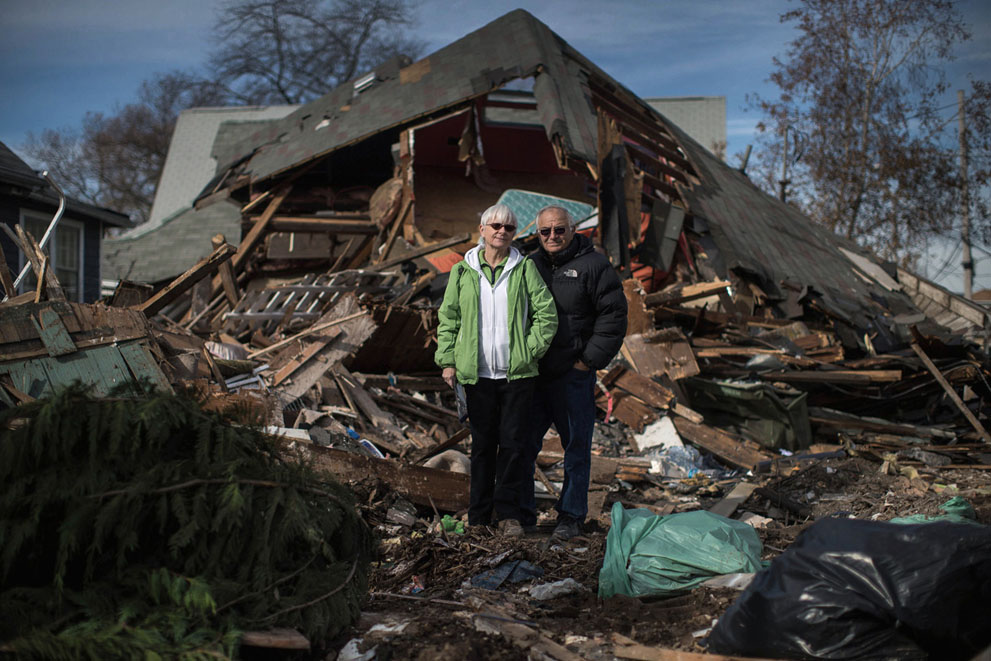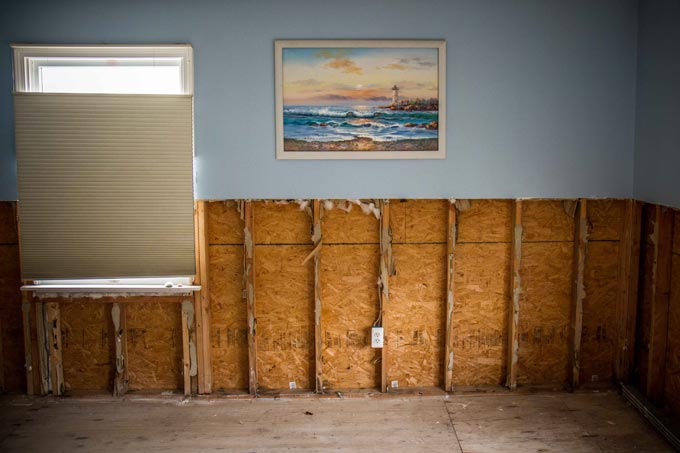In New Orleans, Al Aubry and his family lived for almost three years in a FEMA trailer while they waited for their devastated home to be demolished so they could rebuild after Hurricane Katrina. Now, ten months after Hurricane Sandy, Deborah Turner and her family are also realizing that they may not get back into their home in Brick, New Jersey, anytime soon.
On the eighth anniversary of Hurricane Katrina, families across New York and New Jersey are asking some of the same questions that plagued Gulf Coast residents like Aubry. And perhaps the biggest question of all is, simply: When can I go home?
On August 29, 2005, a staggering 250,000 New Orleans residents were displaced when the levees and flood walls failed during Hurricane Katrina, inundating more than 80 percent of the city. As the U.S. Census Bureau wrote, the “unprecedented displacement of nearly an entire city was unlike anything experienced in the nation’s history.”
Fifteen months after Katrina hit, 100,000 residents were still living in temporary FEMA trailers, while tens of thousands were scattered to the four corners of the country. The government’s inability to cope with the crisis became the storm’s most lasting legacy. (One federal judge even ruled that FEMA’s aid program was unconstitutionally ineffective and compared it to something out of a Kafka novel.)
Al Aubry, an urban farmer, and his family were some of the hundreds of thousands of people cooped up in so-called “temporary,” and reportedly toxic, trailers after their home in Gentilly, New Orleans, was destroyed by the storm. He turned to gardening to cope with the frustration as he waited for the city to demolish his house and for money to come through so he could build anew.
The first year after the storm, Aubry bought a miniature tree to celebrate Christmas in the trailer. By the second anniversary of the hurricane, he had a patch of carrots, green beans, green onions, squash and other vegetables outside the two-room structure. He also had a pink notice on his former home announcing it would be demolished within 30 days. But that deadline came and passed. And the Aubrys went on waiting.
“How come you can’t knock this place down so we can go ahead and rebuild our house and be normal like everyone else in America?” he asked. “All of America is saying, ‘Well, all these people in New Orleans, if they just pull themselves up by their bootstraps and fend for themselves. . . .’ We can build our house, let us do it. If I didn’t have the garden I would go crazy on stuff like this,” he said.
The waiting dragged on so outrageously long that, in February 2008, almost two and half years after the storm, presidential candidate Barack Obama traveled to Tulane University to rally in support of people like Aubry who were “languishing in trailers.” Less than six months later, FEMA took the remaining trailers back. But the reconstruction money didn’t necessarily follow, forcing families like the Aubrys to scatter to find their own temporary living arrangements. Finally, in 2011, Aubry and his wife broke ground on their new home, a full six years after the storm hit.
FEMA and the Bush administration were widely criticized for the convoluted and—some believed—purposefully difficult resettlement and aid process. But even if FEMA has tried to learn from its mistakes, that doesn’t prevent thousands of people across New York and New Jersey from being trapped in the waiting game that Aubry’s family endured.
The FEMA trailer had become the symbol of post-disaster failure and systematic neglect. So it was unsurprising when New York City Mayor Michael Bloomberg declared that the city didn’t need trailers; he and other officials were determined to prevent the appearance of a repeat Katrina performance. Across the river, only a few dozen trailers made it to the roughly 300 miles of devastated New Jersey coastline, stretching from Bergen County south to the Delaware Bay. (A FEMA rule prohibiting trailers in floodplains, which the agency has ignored after past disasters, was invoked to explain to the public the limited rollout.)
New Yorkers affected by Sandy have had to resort to a shoddy patchwork of rental assistance programs and the short-lived Rapid Repairs initiative that barely scratched the surface of need. Meanwhile, New Jersey has created a complex system of rules and government oversight so tightly controlled that state administrators will pick contractors for homeowners and designs must follow a short list preapproved by the state. All this bureaucracy has created an alphabet soup of programs and applications that constitute a great irony for Republicans like Governor Chris Christie who evangelize small government. It’s also a painstaking headache for average residents like Deborah Turner who are trying their best to recover from the storm.
We first met Turner in the People’s Pantry, a community relief center in Toms River, New Jersey. Housed in a cavernous 20,000 square-foot storefront in a suburban shopping plaza on Fischer Boulevard, the Pantry has become a permanent fixture of the community. Like many other middle-class residents in limbo, Turner first came to the Pantry in January seeking aid. She ended up volunteering when she realized that they needed help distributing donations to the more than 5,000 families registered to get weekly supplies. She’s since come on board the tiny staff as the Donations Coordinator.
During our conversation, Turner and a younger staff member played with her infant son, Carson “Hurricane” Turner, who was born less than two months after the storm. Turner explained that she and her husband, a retired police officer, have gutted the house to remove the moldy flooring and sheetrock down to the studs. But they are waiting for the funding to rebuild so they can move back in.
A few weeks later, we visited the Turners at their home in Brick, New Jersey—the house that her newborn son has never lived in. Their neighborhood is made up of a network of narrow streets, alternating between paved roadways and Venetian-style canals that residents call lagoons. The backyard of each house borders neat lanes of water leading to the bay. Groups of kids run in and out of each other’s homes. And even though only a handful of residents have returned, during our afternoon visit a couple of boats drifted down the waterway like it was an ordinary summer day on the Jersey Shore.
Unfortunately, Turner’s ordeal—in which she, her husband, young daughter and dogs had to flee to a nearby house and later be evacuated as the water rose around them—has put a stain on their view of their bucolic neighborhood. Like tens of thousands of homeowners across New York and New Jersey, Turner is struggling to stay afloat in the midst of a mountain of paperwork, changing rules and mortgage payments that make it impossible for her to either rebuild or walk away.
“The only thing they haven’t asked for is a DNA sample,” she said, describing the endless applications for rebuilding assistance. “They need to know everything. I couldn’t put one grant in because I couldn’t find my one month-old son’s social security number. I asked, ‘Why do you need his social security number? He’s a baby.’ They said, ‘We need it all.’ And I was like, ‘Do you think I’m making him up? He’s sitting right here!’”
Twice now FEMA has lost the paperwork Turner has submitted. And even though she’s received flood insurance, it’s not enough to rebuild and raise the house. She’s so frustrated that she would walk away from the property—if not for the mortgage and equity loan she still owes on the house.
Last November, many banks promised to give homeowners affected by Sandy a 90-day grace period on their mortgage payments, while Fannie Mae and Freddie Mac floated a soon-to-expire yearlong grace period. But many said they were offered a mere two-week grace period, if any at all.
Turner and her family are living in a house in the nearby town of Tom’s River with the help of the FEMA rental assistance program as they wait. They are still living near the water, which is unnerving, she says, but she sees many people at the People’s Pantry that haven’t been able to find rental housing and are living in much more precarious situations. And working there offers an important way for her to stay busy and focused on moving forward.
“It helps me through the day, so I’m not home thinking about how bad everything is, or when I’m going to get back into my house,” she explained. “I think it has made me a better mother to my children, because I’m not moping. . . . The more you are with people and the less you feel alone, the better you feel, because you are not the only one going through this.”
3 WAYS TO SHOW YOUR SUPPORT
- Log in to post comments
















